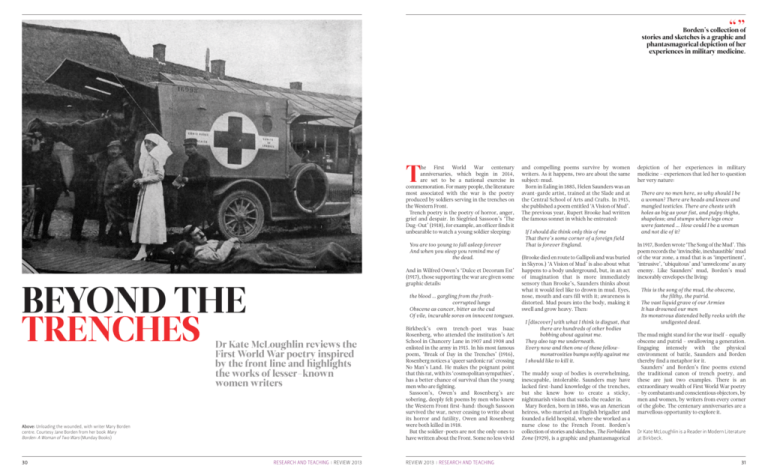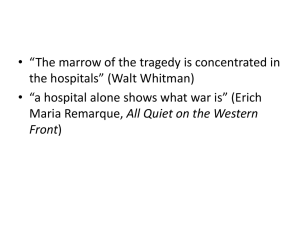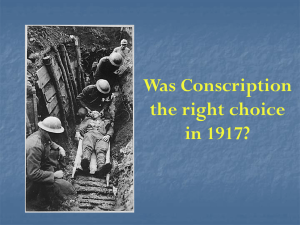Beyond the trenches
advertisement

“” Borden’s collection of stories and sketches is a graphic and phantasmagorical depiction of her experiences in military medicine. he First World War centenary anniversaries, which begin in 2014, are set to be a national exercise in commemoration. For many people, the literature most associated with the war is the poetry produced by soldiers serving in the trenches on the Western Front. Trench poetry is the poetry of horror, anger, grief and despair. In Siegfried Sassoon’s ‘The Dug-Out’ (1918), for example, an officer finds it unbearable to watch a young soldier sleeping: T You are too young to fall asleep forever And when you sleep you remind me of the dead. And in Wilfred Owen’s ‘Dulce et Decorum Est’ (1917), those supporting the war are given some graphic details: BEyOND THE TRENCHES the blood … gargling from the frothcorrupted lungs Obscene as cancer, bitter as the cud Of vile, incurable sores on innocent tongues. Dr Kate McLoughlin reviews the First World War poetry inspired by the front line and highlights the works of lesser-known women writers Above: Unloading the wounded, with writer Mary Borden centre. Courtesy Jane Borden from her book Mary Borden: a Woman of two Wars (Munday Books) 30 RESEaRCH aND tEaCHING REVIEW 2013 Birkbeck’s own trench-poet was Isaac Rosenberg, who attended the institution’s Art School in Chancery Lane in 1907 and 1908 and enlisted in the army in 1915. In his most famous poem, ‘Break of Day in the Trenches’ (1916), Rosenberg notices a ‘queer sardonic rat’ crossing No Man’s Land. He makes the poignant point that this rat, with its ‘cosmopolitan sympathies’, has a better chance of survival than the young men who are fighting. Sassoon’s, Owen’s and Rosenberg’s are sobering, deeply felt poems by men who knew the Western Front first-hand: though Sassoon survived the war, never ceasing to write about its horror and futility, Owen and Rosenberg were both killed in 1918. But the soldier-poets are not the only ones to have written about the Front. Some no less vivid REVIEW 2013 RESEaRCH aND tEaCHING and compelling poems survive by women writers. As it happens, two are about the same subject: mud. Born in Ealing in 1885, Helen Saunders was an avant-garde artist, trained at the Slade and at the Central School of Arts and Crafts. In 1915, she published a poem entitled ‘A Vision of Mud’. The previous year, Rupert Brooke had written the famous sonnet in which he entreated: If I should die think only this of me That there’s some corner of a foreign field That is forever England. (Brooke died en route to Gallipoli and was buried in Skyros.) ‘A Vision of Mud’ is also about what happens to a body underground, but, in an act of imagination that is more immediately sensory than Brooke’s, Saunders thinks about what it would feel like to drown in mud. Eyes, nose, mouth and ears fill with it; awareness is distorted. Mud pours into the body, making it swell and grow heavy. Then: I [discover] with what I think is disgust, that there are hundreds of other bodies bobbing about against me. They also tap me underneath. Every now and then one of these fellowmonstrosities bumps softly against me I should like to kill it. The muddy soup of bodies is overwhelming, inescapable, intolerable. Saunders may have lacked first-hand knowledge of the trenches, but she knew how to create a sticky, nightmarish vision that sucks the reader in. Mary Borden, born in 1886, was an American heiress, who married an English brigadier and founded a field hospital, where she worked as a nurse close to the French Front. Borden’s collection of stories and sketches, The Forbidden Zone (1929), is a graphic and phantasmagorical depiction of her experiences in military medicine – experiences that led her to question her very nature: There are no men here, so why should I be a woman? There are heads and knees and mangled testicles. There are chests with holes as big as your fist, and pulpy thighs, shapeless; and stumps where legs once were fastened … How could I be a woman and not die of it? In 1917, Borden wrote ‘The Song of the Mud’. This poem records the ‘invincible, inexhaustible’ mud of the war zone, a mud that is as ‘impertinent’, ‘intrusive’, ‘ubiquitous’ and ‘unwelcome’ as any enemy. Like Saunders’ mud, Borden’s mud inexorably envelopes the living: This is the song of the mud, the obscene, the filthy, the putrid. The vast liquid grave of our Armies It has drowned our men Its monstrous distended belly reeks with the undigested dead. The mud might stand for the war itself – equally obscene and putrid – swallowing a generation. Engaging intensely with the physical environment of battle, Saunders and Borden thereby find a metaphor for it. Saunders’ and Borden’s fine poems extend the traditional canon of trench poetry, and these are just two examples. There is an extraordinary wealth of First World War poetry – by combatants and conscientious objectors, by men and women, by writers from every corner of the globe. The centenary anniversaries are a marvellous opportunity to explore it. Dr Kate McLoughlin is a Reader in Modern Literature at Birkbeck. 31






